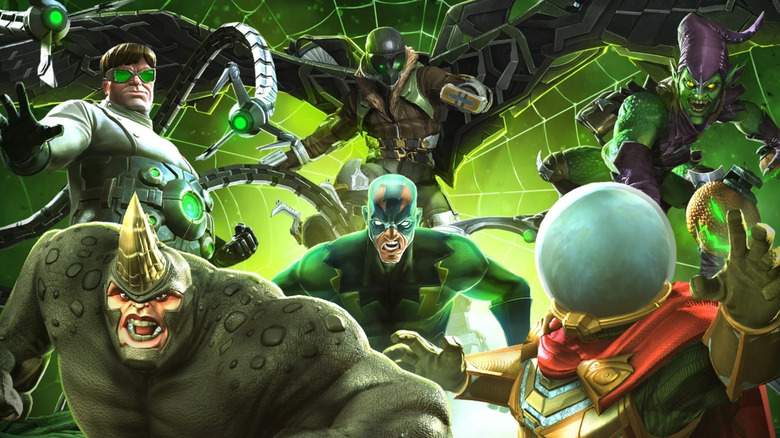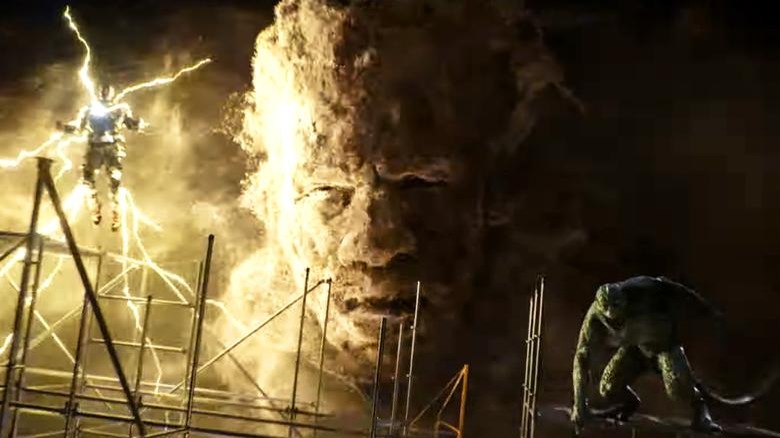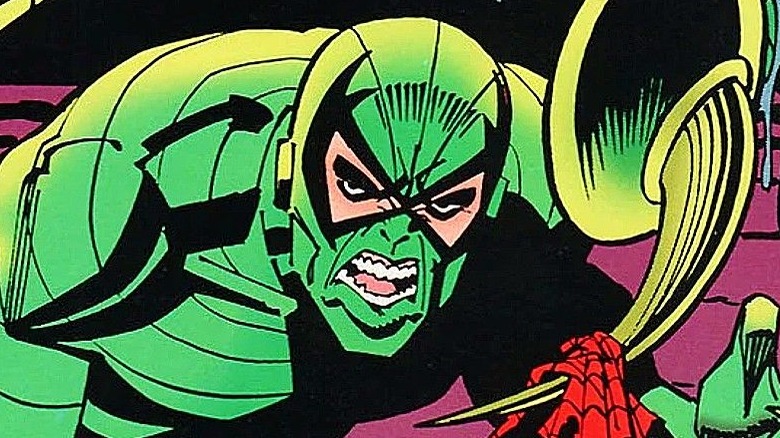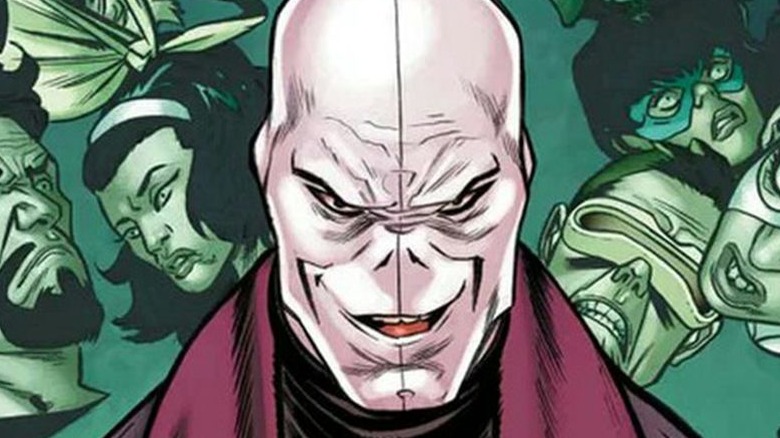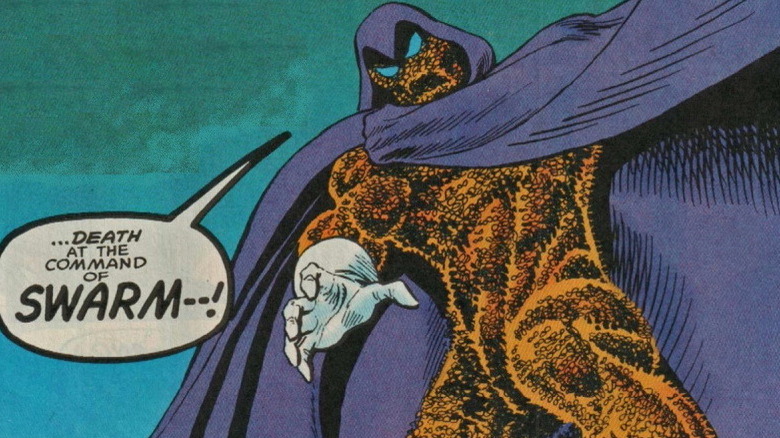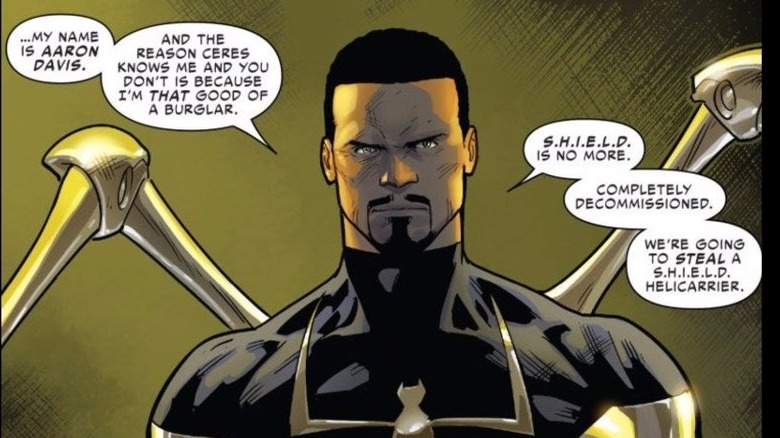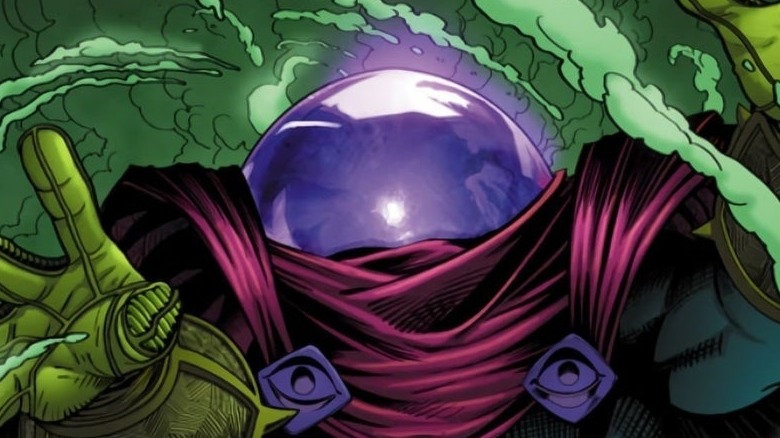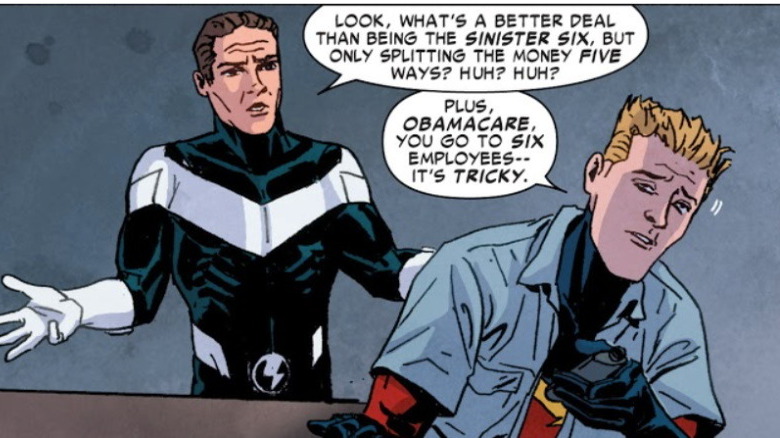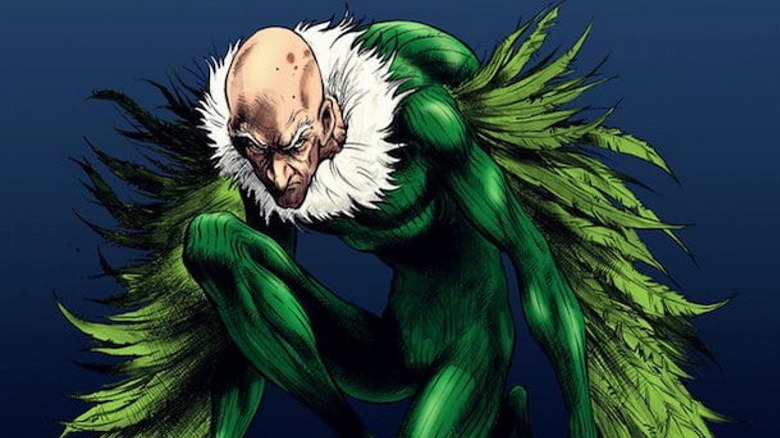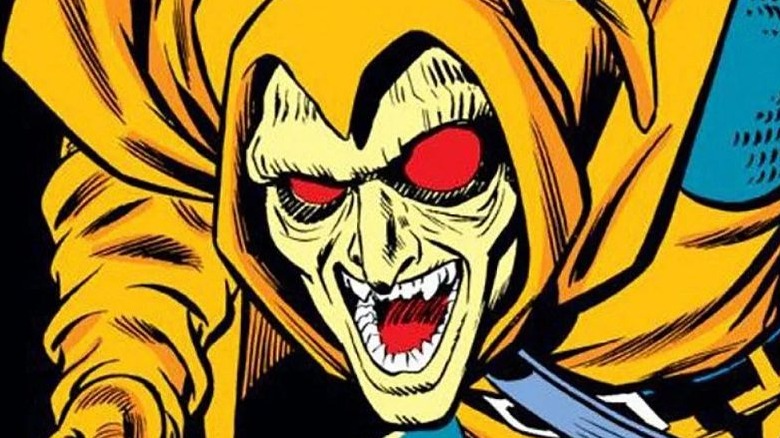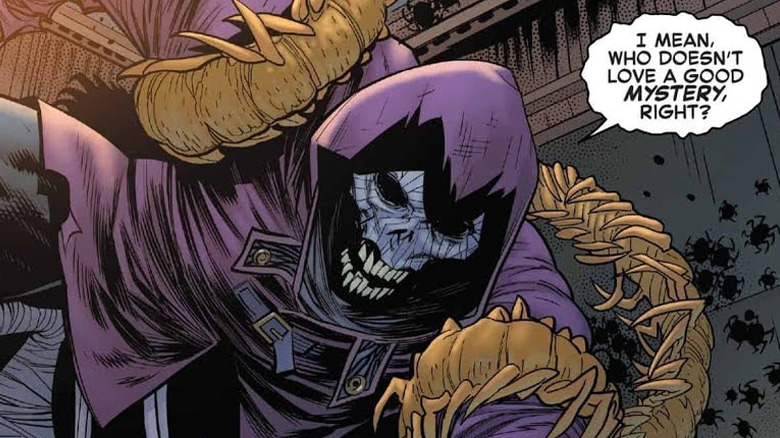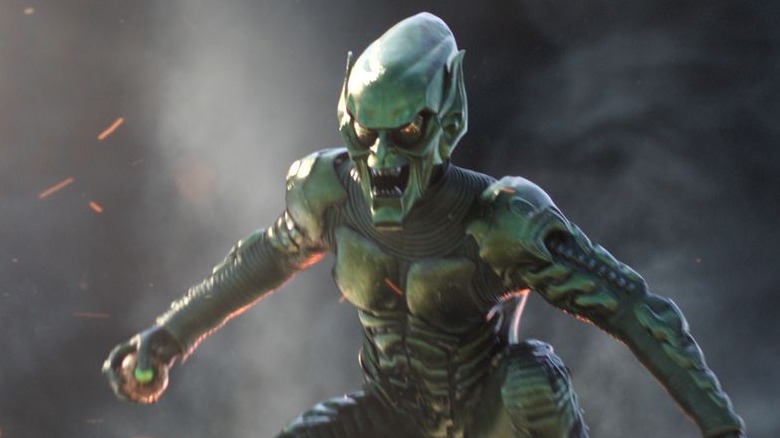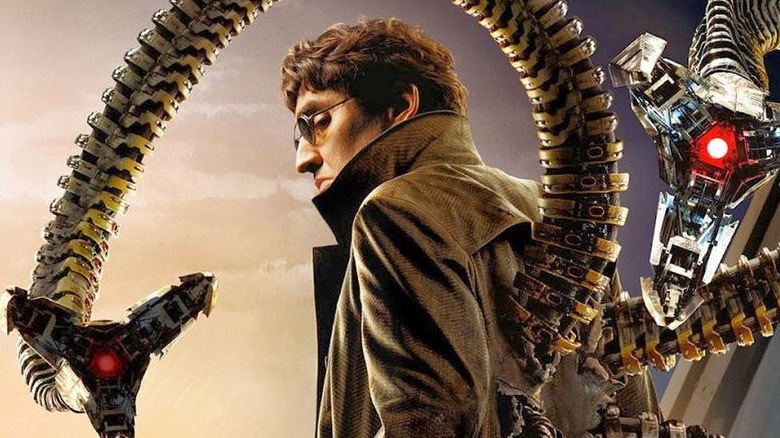Sinister Six Members Ranked By Intelligence
Despite their name, Spider-Man's supervillain team, the Sinister Six, has had far more than six members. Originally created by Stan Lee and Steve Ditko in "The Amazing Spider-Man Annual" #1 to destroy Spider-Man, this group of supervillains has been formed again and again over the years, each time with a new lineup drawn from Spidey's massive rogues' gallery. Occasionally, the team includes far more than six members, although the group usually chooses to keep the name for branding reasons. (Alliteration and numbers are important for comic book teams, after all. Just ask the Fantastic Four.)
While the Sinister Six generally seeks to overwhelm Spider-Man with sheer brute force, their efforts still need to be coordinated by a leader, and the team has had several masterminds over the years, each with their own nefarious plan. With 2021's "Spider-Man: No Way Home" introducing the MCU to a new Sinister Six (well, five, if we're being technical), let's take a look at some of the most notable masterminds from the comics and rank them not simply by their brainpower.
Sandman
Marvel Comics' Sandman (aka" Flint Marko," aka "William Baker") is known for being a lot of things, but a brainiac he isn't. Nevertheless, Spider-Man's longtime foe and sometimes ally once formed his own version of the Sinister Six back in "The Amazing Spider-Man" #12 and "Peter Parker: Spider-Man" #12 in a story by Howard Mackie, John Bryne, and John Romita Jr.
Initially formed as a revenge group against Doctor Octopus, Sandman began by recruiting Electro, Mysterio, Vulture, and Kraven the Hunter. However, things went south the second Mysterio decided to finish the lineup by inviting a sixth member — Venom. As Venom was intent on destroying Spider-Man in those days, he was fine with joining, but when Sandman offered to let Spider-Man go, the symbiote turned on the team and took a bite out of Sandman, nearly killing him. Afterward, Sandman's mental state just kept getting more and more unstable, making him one of the least desirable leaders of a Sinister Six.
Scorpion
When Mac Gargan first became the Scorpion way back in "The Amazing Spider-Man" #20, he was a truly frightening villain with scorpion-like powers that made him more than a match for Spider-Man. Peter nearly died in his first encounter with the villain and only managed to beat him through quick thinking and judicious use of his webbing. Over the years, however, Gargan has become less of a threat and more of a random super-powered thug for Spidey to toss back in jail every now and then. The experiment that granted him his powers also drove him insane, and his questionable mental state has allowed Spider-Man to outwit him again and again.
Even so, Gargan was made the leader of a version of the Sinister Six when Norman Osborn formed his Sinister Twelve in "Marvel Knights Spider-Man" #10. Kidnapping Aunt May so Spider-Man could be blackmailed into breaking Osborn out of jail, Gargan later showed up not as the Scorpion but as a new Venom. After acquiring Eddie Brock's symbiote to gain more power in an attempt to ease his feelings of inadequacy, he's still a major physical threat. Nevertheless, his insecurity and psychosis often get in the way of his intelligence.
Chameleon
Chameleon (real name Dmitri Smerdyakov) occupies a unique place in Spider-Man's rogues gallery. Having appeared in "The Amazing Spider-Man" #1, the shape-shifting bad guy is actually the first villain Spidey fought who could be called a "supervillain." Originally a master mimic who could disguise himself with "Mission Impossible"-style masks, Chameleon eventually acquired genuine shape-shifting abilities that allowed him to fool anyone into buying his impersonations.
Well, unless you're Spider-Man, that is. Thanks to Peter Parker's spider-sense and keen intellect, he can often spot the flaws in Chameleon's disguises and unmask the villain. This is embarrassingly true in "Spider-Man and the X-Men" #3, when Chameleon kidnaps Spidey and a group of young mutants he's teaching just so he can bring them to the alien planet Mojoworld and have them appear on alien producer Mojo's TV show.
Using Mojo's advanced technology, Chameleon creates holographic duplicates of dozens of Spider-Man's enemies and creates the Sinister Sixty-Six. Despite this, Spidey and his team easily take out the holograms, and the hero unmasks the Chameleon three different times. If the master of disguise isn't that good at his main gimmick, his brainpower is not exactly top-notch.
Swarm
Swarm is a particularly creepy Spider-Man villain. An ex-Nazi scientist who was hiding out in South America by working as a beekeeper, Fritz von Meyer was devoured by a swarm of mutated bees that absorbed his consciousness and resurrected him as the composite being Swarm.
Having his mind housed in thousands of bees might suggest Swarm is hyper-intelligent, but that's definitely not the case in "Spider-Man and the X-Men" #4. Barely an issue after Spidey's team of young mutants defeats Chameleon's Sinister Sixty-Six, they make mincemeat out of Swarm's C-List version of the Sinister Six in a fight that lasts a record six pages. By the end, powerful mutant Hellion blasts Swarm into oblivion, and his teammates immediately surrender after seeing their leader get literally squished to death. When one of Spidey's students complains that the fight was "disappointingly easy," you know the opposition is led by a guy with questionable leadership abilities.
Evil Iron Spider
Fans of Miles Morales' Spider-Man and 2018's "Into the Spider-Verse" know that Miles' Uncle Aaron is a villainous version of the Prowler. In both "Into the Spider-Verse" and the 2017's live-action "Spider-Man: Homecoming," Aaron (Donald Glover) shows he has a heart despite his criminal activities and regularly tries to look out for Miles.
In "Spider-Man" #234, however, Aaron got his hands on a version of the Iron Spider suit and formed his own version of the Sinister Six. Boasting a lineup that included Hobgoblin, Bombshell, Sandman, Spot, and a new Electro, Aaron's team was created to steal a decommissioned S.H.I.E.L.D. Helicarrier and sell it to Latverian politician Lucia von Baradas.
While his team possessed the specialized skills he required, the new Iron Spider wasn't exactly good at inspiring loyalty among his teammates, and the Hobgoblin ultimately sold out the team. Aaron ended up coming into conflict with his nephew and nearly died, only to survive and abandon his life of crime. Smart choice, but the decisions he made up till then were pretty stupid, so he ranks fairly low on this list.
Mysterio
Mysterio is often an underestimated Spider-Man foe. Although he doesn't possess any innate superpowers, Mysterio is a master manipulator and illusionist who learned how to block out Spider-Man's spider-sense with his psychedelic chemical mists early on. As such, he's skilled at getting people to do what he wants them to — although this ability seemed to fail him in "Peter Parker: Spider-Man" #12 when he usurped Sandman's leadership role and made the dubious choice of bringing Venom onto the Sinister Six. Venom ended up coming in conflict with his new teammates, and the in-fighting destroyed the team from within.
About the only saving grace here is that it wasn't the original Mysterio — Quentin Beck — behind the fishbowl mask. This Mysterio was actually Daniel Berkhart, a stuntman who had once worked with Beck. Hired by J. Jonah Jameson to harass Spider-Man, this new Mysterio was arrested and later popped up in comics haphazardly.
Boomerang
Despite his trick boomerangs and uncanny ability to never miss a target, Boomerang (Fred Myers) often comes across as a bargain-basement Bullseye. Usually serving as low-level muscle on other supervillain teams, Boomerang later created his own Sinister Six in "The Superior Foes of Spider-Man. Well, sort of. Actually, his group only had five members, but Fred decided the brand recognition was too good to pass up. He even convinced his team that calling themselves "Sinister Six" and splitting the money five ways was a good deal. A couple of issues later, he got kicked off the team (guess the others liked the idea of splitting money four ways better).
Later, deciding downsizing was a bad idea, Fred created the Sinister Sixteen to steal from the Chameleon, but most of the new members got captured. Seemingly wising up, Boomerang quit the supervillain racket and began sharing an apartment with none other than Peter Parker. This put him into conflict with Spider-Man, but Fred managed to convince his former enemy that he really was trying to be good, and the two became friends.
So, it was disappointing when Fred became the leader of a new Sinister Six (or "Superior Foes") during the Sinister War event. Fortunately, Fred still had some decency left in him and decided to help Spider-Man — only to get killed by the Inheritor Morlun. It was a heroic death, but one he only achieved thanks to a long line of bad choices.
Vulture
Vulture (Adrian Toomes) has always been one of Spider-Man's more intelligent foes. The inventor of a special antigravity device that grants him superhuman strength, Vulture has had successful stints as both a solo supervillain (usually a thief) and a team player. In fact, while on Doctor Octopus' version of the Sinister Six, Octavius himself consulted Toomes on the viability of their plans.
Later on, Vulture assembled his own team of animal-themed villains that included King Cobra, Rhino, Scorpion, Tarantula, and Stegron the Dinosaur Man to create the Savage Six. Their reasons for joining have more to do with ego than power, however — they wanted to get revenge on Mysterio (another former Sinister Six villain) for creating a movie using their likenesses without their permission.
Mysterio manages to trick the Savage Six with his illusions, but the team returns — only to get the stuffing beaten out of them by Mary Jane and a bunch of D-List ex-supervillains. Given that these are some of Spider-Man's most powerful villains, the ease with which they get (repeatedly) beaten doesn't speak well of the Vulture's leadership skills.
Hobgoblin
There have actually been multiple versions of the Hobgoblin over the years, with the original, Roderick Kingsley, proving himself a true mastermind as he hid his true identity behind multiple fall guys. One of these people was Peter Parker's friend Ned Leeds, whom he brainwashed into thinking they really were supervillains. Kingsley's successors, however, have not been as intelligent.
Take Jason Phillip Macendale Jr., for instance. Originally a soldier of fortune who decided he could make more money as a supervillain, Macendale initially began flying around town with a pumpkin head mask and called himself "Jack O'Lantern." Later, he assumed the identity of the Hobgoblin and got bonded with a real-life demon that drove him insane. Doctor Octopus decided to recruit this Hobgoblin into one of his Sinister Six lineups, but he was little more than a petty thug.
Macendale eventually split from his demonic half and formed a new Sinister Seven in "Spider-Man Unlimited" #9 to seek out Kaine, a clone of Spider-Man who was killing multiple members of Spidey's rogues' gallery. Despite their mutual interest in surviving, Macendale's team could only bicker with each other and were nearly all killed by Kaine until Mysterio managed to trick Kaine into attacking Spider-Man ... by making Kaine believe Spidey was the Hobgoblin. Clearly not this Hobgoblin's finest hour.
Kindred
Sometimes it's not the field leader you need to worry about but the evil mastermind in the background pulling all the strings. During the Sinister War, Spider-Man learned the villainous Kindred had helped assemble not one, not two, but six different versions of the Sinister Six for a grand total of 36 villains. Created as part of a contest to see which team could take out Spider-Man first, the multiple Sinister Sixes nearly overwhelmed Spidey with their sheer manpower, although the web-slinger did come out on top.
Actually, what made Kindred such a devious mastermind is that you never knew who or what he was. Initially, it looked like he was a demonic version of Peter Parker's friend Harry Osborn that came back from the dead. Then it turned out the Harry Osborn that Peter was friends with was actually a clone. Then we learned "Kindred" was actually an identity shared by Sarah and Gabriel Stacy — the alleged illegitimate children of Norman Osborn and Gwen Stacy. And the pair were actually clones created by an AI version of Harry Osborn and later turned into demonic soldiers by Marvel's version of Satan, Mephisto.
And yes, before you ask, writing out that convoluted explanation left us just as confused as you are. He/she/it/they might be the most bizarre character on this list, but hey — nobody can say Kindred isn't a master of misdirection.
Green Goblin
Although he's known as one of Spider-Man's greatest foes, the original Green Goblin (Norman Osborn) was never a part of the early lineups of the Sinister Six. This changed in "Marvel Knights: Spider-Man" when he formed his own team while he was still incarcerated. But while previous versions had limited themselves to six members, Osborn eschewed alliteration in favor of firepower by founding the Sinister Twelve.
In terms of muscle, this team was pretty scary. As if having a psycho as the Green Goblin wasn't bad enough, Spidey also had to battle Hydro-Man, Lizard, Sandman, Tombstone, Vulture, Shocker, Hammerhead, Electro, Boomerang, and the Chameleon. Even worse, longtime Spider-Man foe Scorpion was also on the team and had given himself a power upgrade by becoming the new Venom.
Brilliant as Osborn may be, his volatile state of mind also causes him to make some questionable choices. Nowhere is this better illustrated than in the much-ridiculed "Spider-Man: Turn Off the Dark" musical, where Osborn builds a new Sinister Six from scratch by mutating research scientists into becoming new versions of Carnage, Electro, Lizard, Swarm, Kraven the Hunter ... and a woman made of knives that he calls "Swiss Miss." You're a smart guy, Norman, but creating a singing and dancing Sinister Six is just plain stupid.
Doctor Octopus
Was there any doubt over which supervillain would take the top spot? Doctor Otto Octavius isn't just the Sinister Six's most intelligent member — he's the team's founder. Way back in "The Amazing Spider-Man Annual" #1, Doctor Octopus brought together the Vulture, Sandman, Mysterio, Kraven the Hunter, and Electro to take down Spider-Man. While their efforts failed, Doc Ock made Spider-Man run a grueling gauntlet and even laid the seeds for his later relationship with Aunt May.
Octavius would rebuild his Sinister Six, again and again, each time with a different lineup. What made Doctor Octopus a particularly devious leader was that he would keep manipulating his team to achieve his own ends. He blackmailed a reformed Sandman into becoming a villain again and fooled his teammates into stealing a drug that would let him extort the world's wealthy and powerful ... on his own. Considering how many times Doc Ock double-crossed his partners, the fact that they keep wanting to be part of his Sinister Sixes says a lot about his ability to control others.
This manipulation would reach even greater heights when Octavius took over Peter Parker's body to become the "Superior" Spider-Man. In "The Superior Spider-Man Team-Up" #5, Ock used mind-controlling technology on his old partners to force the now Superior Six into performing heroic deeds, then locked them up in between missions. Naturally, the mind-control failed, and the villains ran amok. But for a while, Octavius really did prove he was the ultimate evil genius.
